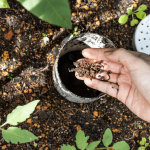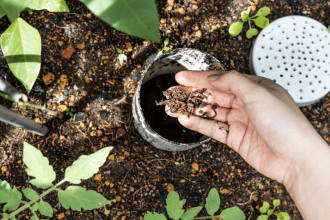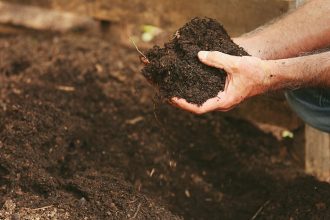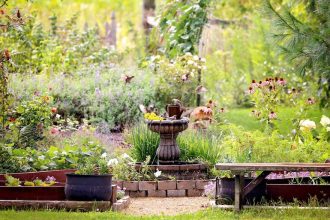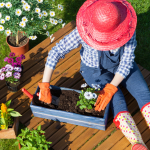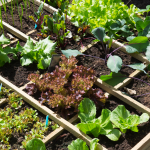In the lush world of organic gardening, a symbiotic dance between plants unfolds under the open sky. Companion planting, an age-old technique, weaves a tapestry of harmony and balance in the garden bed. Join us as we delve into the marvels of companion planting in organic gardens, where plants forge friendships that nourish and protect each other in their quest for flourishing abundance.

Introduction: The Benefits of Companion Planting in Organic Gardens
Companion planting is a gardening technique where different plants are grown in close proximity to provide benefits to one another. In organic gardens, companion planting is not only a sustainable practice but also offers numerous advantages for plant health and overall garden productivity.
One of the key benefits of companion planting is pest control. By strategically planting certain companion plants together, you can naturally deter pests and reduce the need for chemical pesticides. For example, planting marigolds alongside tomatoes can help repel nematodes, while growing basil near tomatoes can ward off tomato hornworms.
In addition to pest control, companion planting can also improve soil health and fertility. Certain plants have the ability to fix nitrogen in the soil, attracting beneficial insects, and improving overall soil structure. For example, planting legumes like beans or peas alongside corn can help replenish nitrogen levels in the soil, resulting in healthier and more productive crops.
Plant Combinations that Promote Pest Control and Disease Prevention
When it comes to organic gardening, one effective way to naturally control pests and prevent diseases is through companion planting. By strategically pairing certain plants together, you can create a harmonious environment that deters harmful insects and promotes overall plant health.
One popular combination is planting marigolds alongside tomatoes. Marigolds are known for their ability to repel harmful nematodes, while also attracting beneficial insects like ladybugs and hoverflies. By planting them near your tomato plants, you can help protect them from common pests such as aphids and whiteflies.
Another effective pairing is basil and tomatoes. Basil not only enhances the flavor of tomatoes when used in cooking, but it also helps to repel mosquitoes and flies. Additionally, the strong aroma of basil can mask the scent of tomatoes, making it harder for pests to locate them.
Companion Planting for Improved Soil Health and Nutrient Absorption
Companion planting is a popular technique used in organic gardens to promote soil health and improve nutrient absorption in plants. By strategically planting different species together, gardeners can create a more balanced ecosystem that supports plant growth and vitality.
One common example of companion planting is the Three Sisters method used by Native American tribes, where corn, beans, and squash are planted together. Corn provides a natural trellis for the beans to climb, while the beans fix nitrogen in the soil, benefiting the corn. The squash then acts as a living mulch, shading the soil and helping to retain moisture.
Other beneficial plant pairings include:
- Tomatoes and basil: Basil repels pests that commonly affect tomatoes, while also improving their flavor.
- Carrots and onions: Onions deter carrot flies, while carrots help to break up the soil for easier onion growth.
- Lettuce and radishes: Radishes attract beneficial insects that prey on lettuce pests, helping to keep your greens healthy.
| Plant 1 | Plant 2 | Benefit |
|---|---|---|
| Cucumbers | Dill | Dill attracts pollinators to help with cucumber fruit set. |
| Peas | Mint | Mint deters pests that commonly affect peas, improving yield. |
Strategic Pairings for Maximizing Space and Enhancing Crop Yields
When planning your organic garden, it’s important to consider strategic pairings of plants that will not only maximize space but also enhance crop yields. Companion planting is a technique that has been used for centuries to create beneficial relationships between different types of plants. By pairing certain plants together, you can help control pests, improve soil health, and even increase the overall productivity of your garden.
One classic example of companion planting is the Three Sisters method, where corn, beans, and squash are planted together. This traditional Native American technique takes advantage of the unique attributes of each plant – the corn provides a structure for the beans to climb, the beans add nitrogen to the soil, and the squash acts as a living mulch, suppressing weeds and retaining moisture.
Other strategic pairings to consider include:
- Tomatoes and Basil: Planting these two together can help improve the flavor of your tomatoes and deter pests.
- Cucumbers and Sunflowers: Sunflowers provide shade for the cucumbers while attracting beneficial insects.
- Carrots and Onions: Interplanting these two can help repel pests and maximize space in your garden.
| Plant Pairing | Benefits |
|---|---|
| Tomatoes and Basil | Improved flavor and pest control |
| Cucumbers and Sunflowers | Shade and beneficial insect attraction |
| Carrots and Onions | Pest repellant and space maximization |
In conclusion, companion planting in organic gardens is a harmonious and natural way to promote plant health and productivity. By strategically pairing plants that benefit each other, you can create a thriving ecosystem that minimizes the need for chemical pesticides and fertilizers. So, next time you’re planning your garden, consider the companionship of your plants and watch as they flourish together in perfect harmony. Happy gardening!


